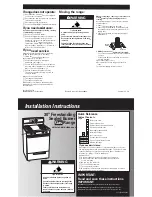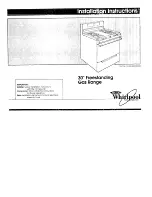
The shelves are designed with stop-locks
so when placed correctly on the shelf
supports, they will stop before coming
completely out of the oven and will not
tilt when you are removing food from
them or placing food on them.
When placing cookware on a shelf,
pull the shelf out to the bump on the
shelf support. Place the cookware on the
shelf, then slide the shelf back into the
oven. This will eliminate reaching into
the hot oven.
To remove the shelves
from the oven, pull
them toward you, tilt front end upward
and pull them out.
To replace,
place shelf on shelf support
with stop-locks (curved extension of
shelf) facing up and toward back of oven.
Tilt up front and push shelf toward back
of oven until it goes past the bump on
the shelf support. Then lower front of
shelf and push it all the way back.
Oven Shelves
Bump
10
The oven has four shelf supports—
A
(bottom),
B, C
and
D
(top).
Shelf positions for cooking are suggested
in the
Using your oven for baking and
Using your oven for roasting sections.
Oven Shelf Positions
A
B
C
D
The oven has 4 shelf positions.
Oven Vents
Do not leave plastic items on the
cooktop—they may melt if left too
close to the vent.
The oven is vented through
duct openings at the front of the
backsplash.
Do not block the opening when
cooking in the oven—it is important
that the flow of hot air from the oven
and fresh air to the oven burner be
uninterrupted.
The vent openings and nearby surfaces
may become hot during baking and
broiling. Do not touch them.
Handles of pots and pans on the
cooktop may become hot if left too
close to the vent.
Metal items will become very hot if
they are left on the cooktop and could
cause burns.
Do not leave any items on the cooktop.
The hot air from the vent may ignite
flammable items and will increase
pressure in closed containers, which
may cause them lo burst.
Safety Instructions
Operating
Instructions
Care and Cleaning
Installation
Instructions
Troubleshooting T
ips
Consumer Support











































